Foodco Holding: Analysis of Business Operations with Balance Scorecard
VerifiedAdded on 2022/08/21
|18
|3771
|14
Report
AI Summary
This report analyzes the business operations of Foodco Holding, an Abu Dhabi-based conglomerate, through the lens of the balance scorecard (BSC). The study begins with an introduction to the BSC, its components, and its importance as a strategic management tool. It then provides a literature review, discussing the BSC's impact on organizational performance, its role in risk management, and the challenges associated with its implementation. The report proceeds to give an overview of Foodco Holding, including its structure and financial performance. The methodology used to explore, investigate, and analyze the data is presented. The analysis of the data gathered, the results reached, and recommendations for the company are then discussed, including strategies for more aggressive marketing and foreign expansion. The report concludes by referencing relevant sources and presents the analysis of Foodco Holding's business operations using the balance scorecard.
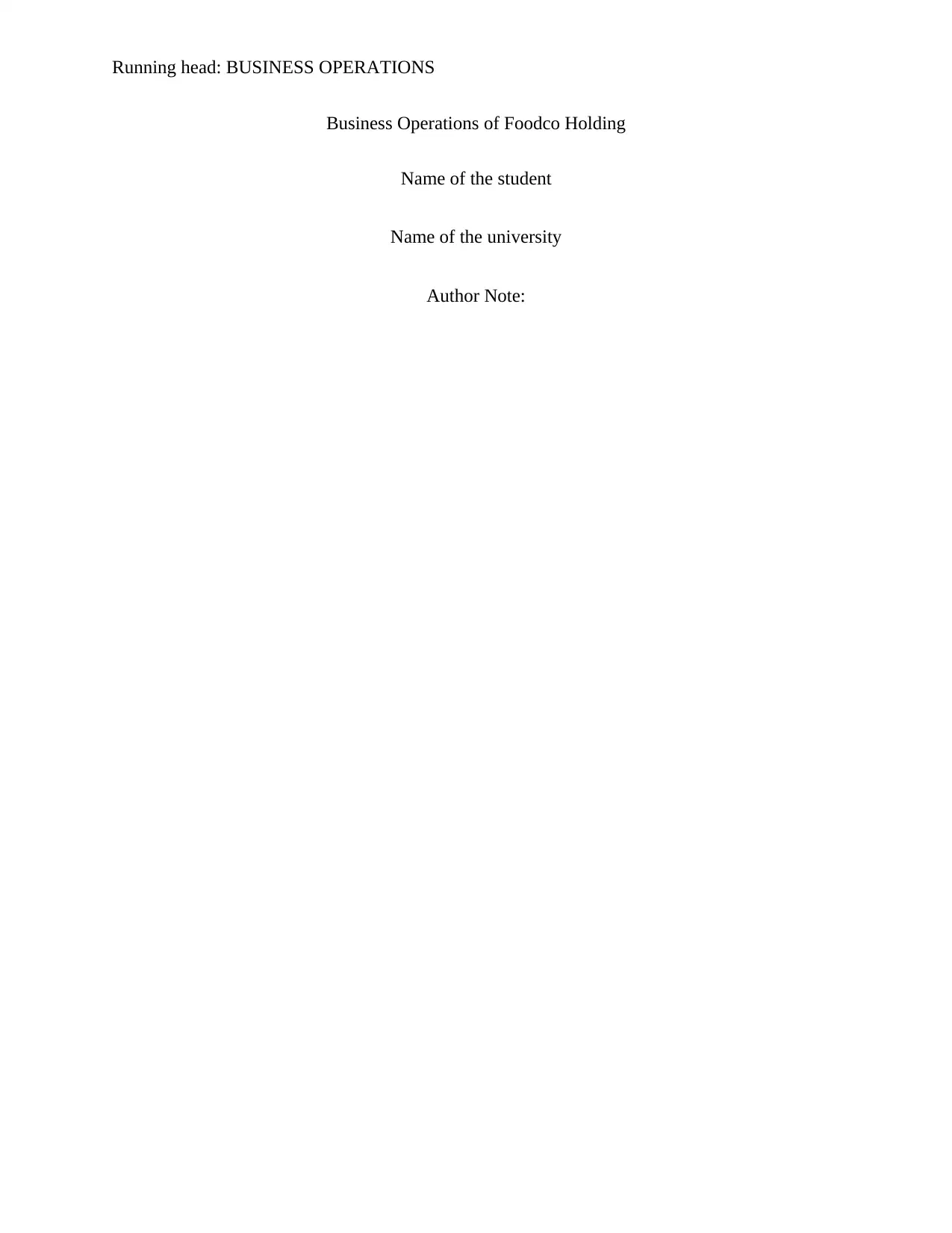
Running head: BUSINESS OPERATIONS
Business Operations of Foodco Holding
Name of the student
Name of the university
Author Note:
Business Operations of Foodco Holding
Name of the student
Name of the university
Author Note:
Paraphrase This Document
Need a fresh take? Get an instant paraphrase of this document with our AI Paraphraser
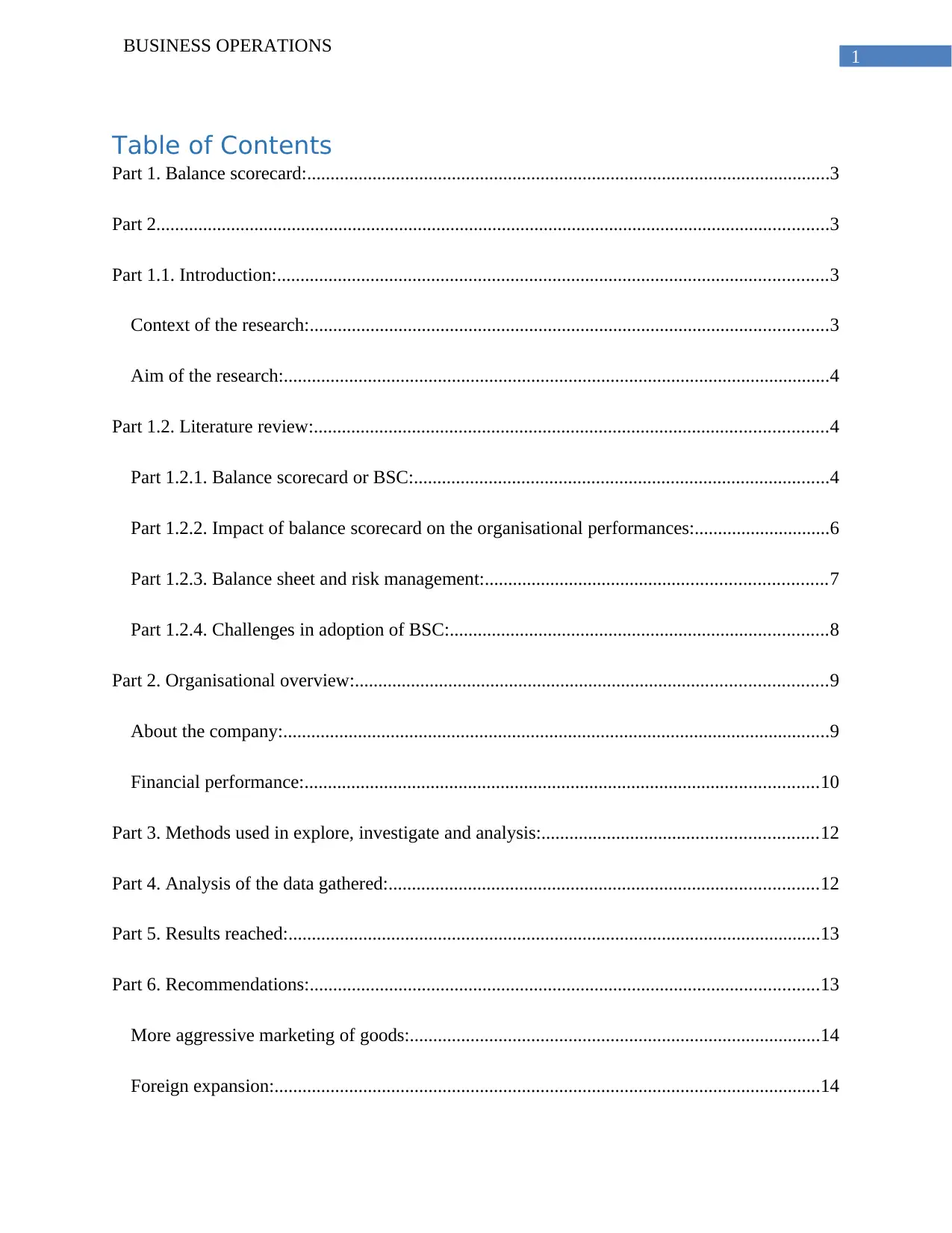
1
BUSINESS OPERATIONS
Table of Contents
Part 1. Balance scorecard:................................................................................................................3
Part 2................................................................................................................................................3
Part 1.1. Introduction:......................................................................................................................3
Context of the research:...............................................................................................................3
Aim of the research:.....................................................................................................................4
Part 1.2. Literature review:..............................................................................................................4
Part 1.2.1. Balance scorecard or BSC:.........................................................................................4
Part 1.2.2. Impact of balance scorecard on the organisational performances:.............................6
Part 1.2.3. Balance sheet and risk management:.........................................................................7
Part 1.2.4. Challenges in adoption of BSC:.................................................................................8
Part 2. Organisational overview:.....................................................................................................9
About the company:.....................................................................................................................9
Financial performance:..............................................................................................................10
Part 3. Methods used in explore, investigate and analysis:...........................................................12
Part 4. Analysis of the data gathered:............................................................................................12
Part 5. Results reached:..................................................................................................................13
Part 6. Recommendations:.............................................................................................................13
More aggressive marketing of goods:........................................................................................14
Foreign expansion:.....................................................................................................................14
BUSINESS OPERATIONS
Table of Contents
Part 1. Balance scorecard:................................................................................................................3
Part 2................................................................................................................................................3
Part 1.1. Introduction:......................................................................................................................3
Context of the research:...............................................................................................................3
Aim of the research:.....................................................................................................................4
Part 1.2. Literature review:..............................................................................................................4
Part 1.2.1. Balance scorecard or BSC:.........................................................................................4
Part 1.2.2. Impact of balance scorecard on the organisational performances:.............................6
Part 1.2.3. Balance sheet and risk management:.........................................................................7
Part 1.2.4. Challenges in adoption of BSC:.................................................................................8
Part 2. Organisational overview:.....................................................................................................9
About the company:.....................................................................................................................9
Financial performance:..............................................................................................................10
Part 3. Methods used in explore, investigate and analysis:...........................................................12
Part 4. Analysis of the data gathered:............................................................................................12
Part 5. Results reached:..................................................................................................................13
Part 6. Recommendations:.............................................................................................................13
More aggressive marketing of goods:........................................................................................14
Foreign expansion:.....................................................................................................................14
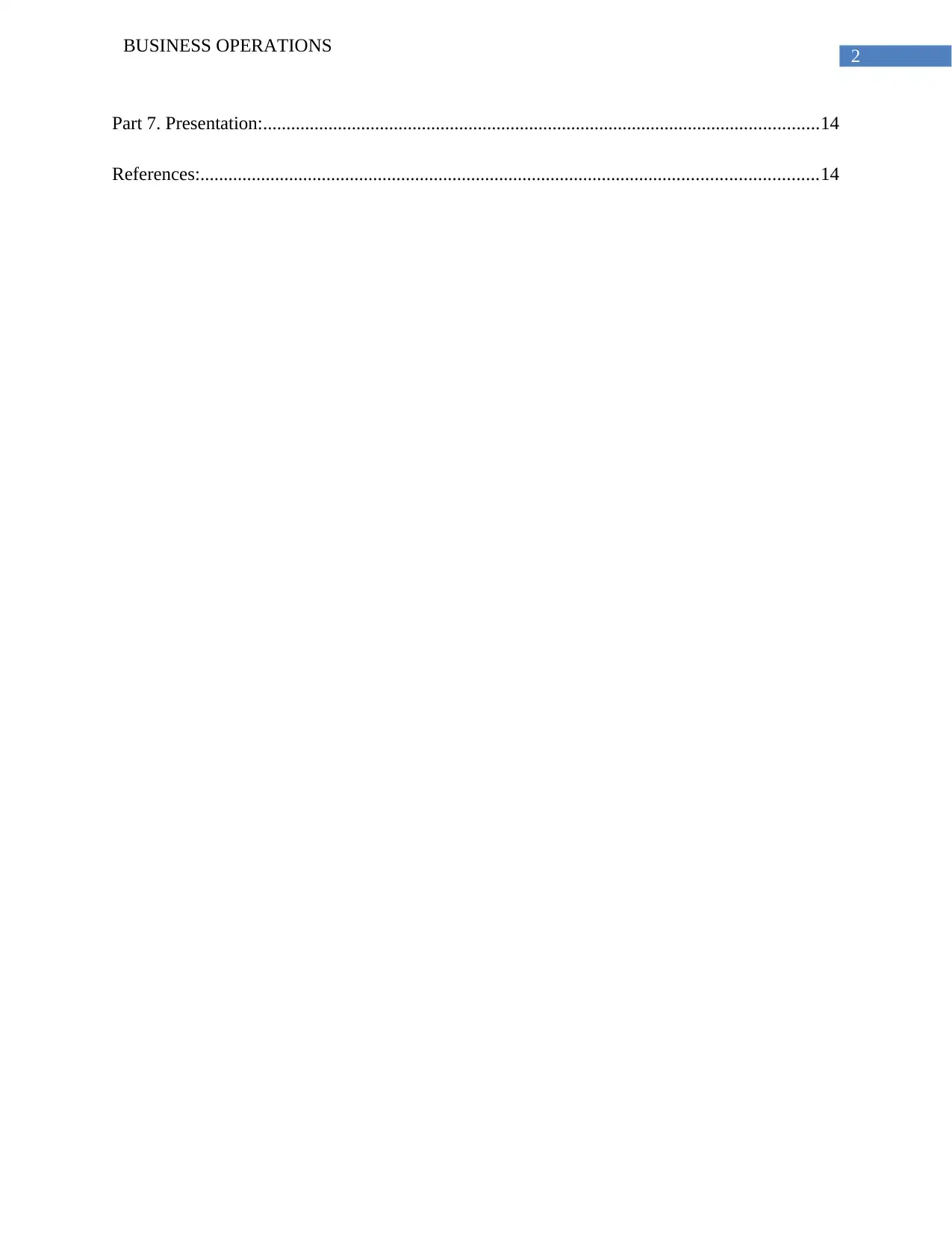
2
BUSINESS OPERATIONS
Part 7. Presentation:.......................................................................................................................14
References:....................................................................................................................................14
BUSINESS OPERATIONS
Part 7. Presentation:.......................................................................................................................14
References:....................................................................................................................................14
⊘ This is a preview!⊘
Do you want full access?
Subscribe today to unlock all pages.

Trusted by 1+ million students worldwide
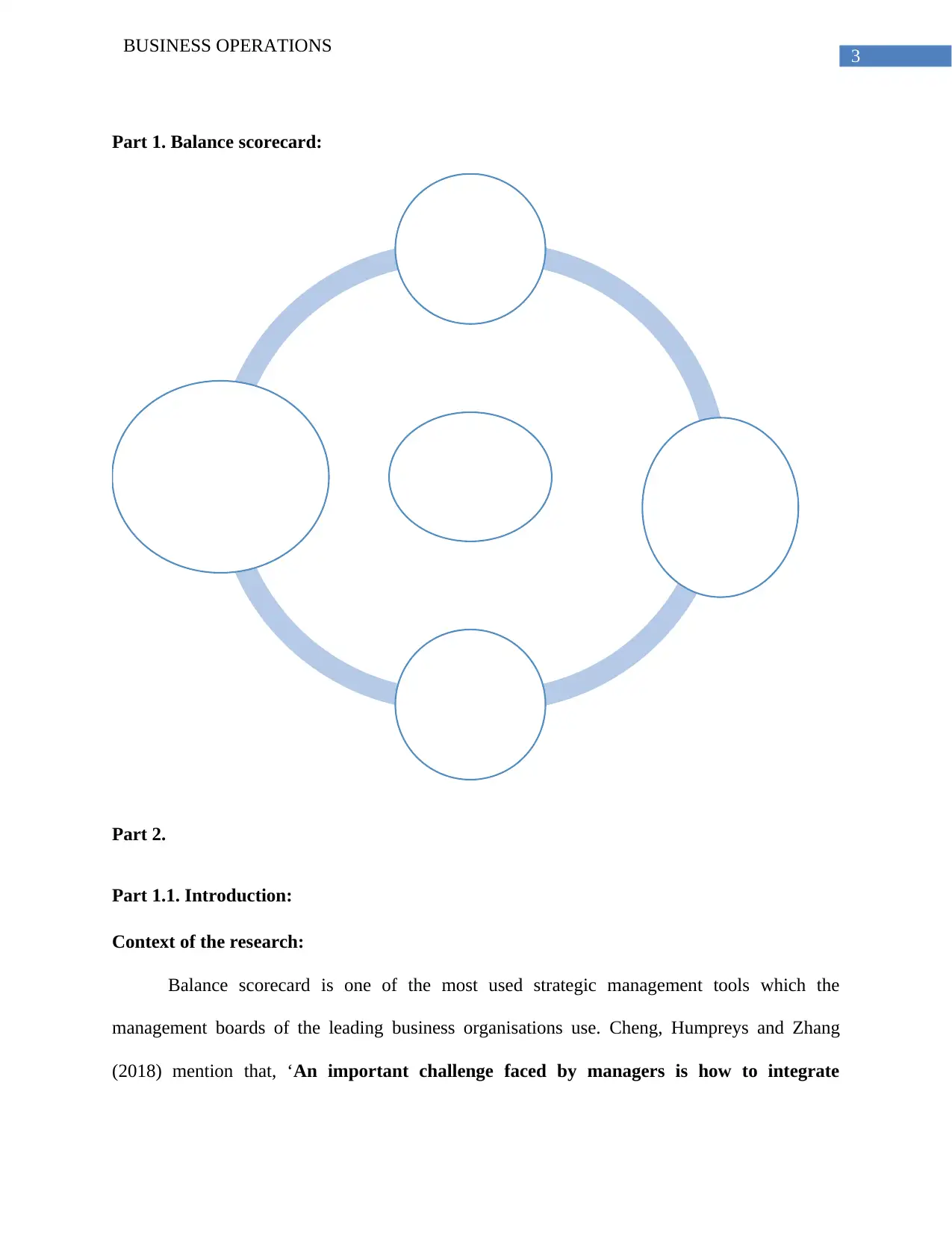
3
BUSINESS OPERATIONS
Part 1. Balance scorecard:
Part 2.
Part 1.1. Introduction:
Context of the research:
Balance scorecard is one of the most used strategic management tools which the
management boards of the leading business organisations use. Cheng, Humpreys and Zhang
(2018) mention that, ‘An important challenge faced by managers is how to integrate
Mission and
strategies of
Foodco
Cutomers(B2C
and B2B)
Financial(revenu
e, share capital,
ROI etc)
Internal
processes(Man
ufacturing,
procurement,
etc)
Organisational
capacity(Prdocuts,
manpwer etc)
BUSINESS OPERATIONS
Part 1. Balance scorecard:
Part 2.
Part 1.1. Introduction:
Context of the research:
Balance scorecard is one of the most used strategic management tools which the
management boards of the leading business organisations use. Cheng, Humpreys and Zhang
(2018) mention that, ‘An important challenge faced by managers is how to integrate
Mission and
strategies of
Foodco
Cutomers(B2C
and B2B)
Financial(revenu
e, share capital,
ROI etc)
Internal
processes(Man
ufacturing,
procurement,
etc)
Organisational
capacity(Prdocuts,
manpwer etc)
Paraphrase This Document
Need a fresh take? Get an instant paraphrase of this document with our AI Paraphraser
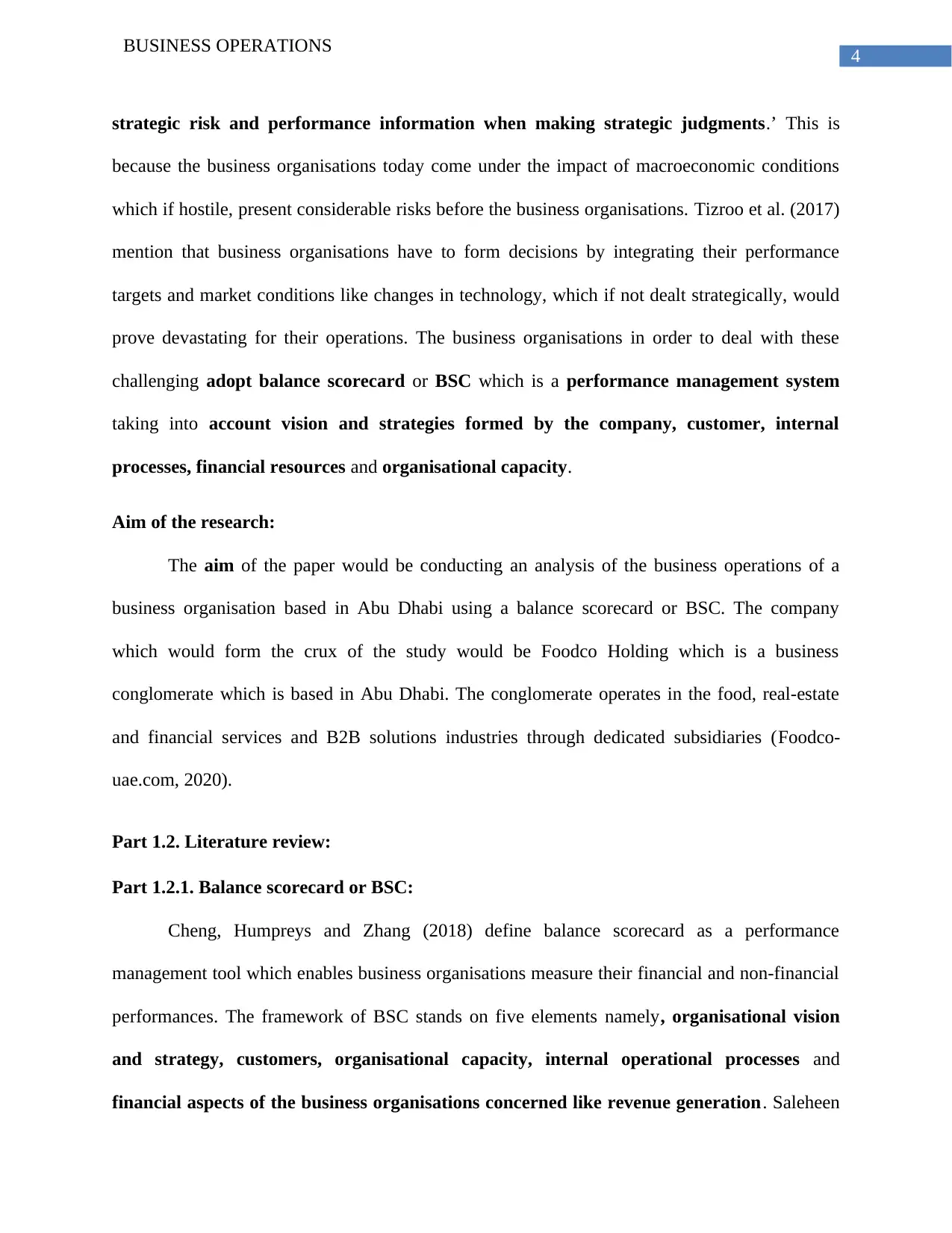
4
BUSINESS OPERATIONS
strategic risk and performance information when making strategic judgments.’ This is
because the business organisations today come under the impact of macroeconomic conditions
which if hostile, present considerable risks before the business organisations. Tizroo et al. (2017)
mention that business organisations have to form decisions by integrating their performance
targets and market conditions like changes in technology, which if not dealt strategically, would
prove devastating for their operations. The business organisations in order to deal with these
challenging adopt balance scorecard or BSC which is a performance management system
taking into account vision and strategies formed by the company, customer, internal
processes, financial resources and organisational capacity.
Aim of the research:
The aim of the paper would be conducting an analysis of the business operations of a
business organisation based in Abu Dhabi using a balance scorecard or BSC. The company
which would form the crux of the study would be Foodco Holding which is a business
conglomerate which is based in Abu Dhabi. The conglomerate operates in the food, real-estate
and financial services and B2B solutions industries through dedicated subsidiaries (Foodco-
uae.com, 2020).
Part 1.2. Literature review:
Part 1.2.1. Balance scorecard or BSC:
Cheng, Humpreys and Zhang (2018) define balance scorecard as a performance
management tool which enables business organisations measure their financial and non-financial
performances. The framework of BSC stands on five elements namely, organisational vision
and strategy, customers, organisational capacity, internal operational processes and
financial aspects of the business organisations concerned like revenue generation. Saleheen
BUSINESS OPERATIONS
strategic risk and performance information when making strategic judgments.’ This is
because the business organisations today come under the impact of macroeconomic conditions
which if hostile, present considerable risks before the business organisations. Tizroo et al. (2017)
mention that business organisations have to form decisions by integrating their performance
targets and market conditions like changes in technology, which if not dealt strategically, would
prove devastating for their operations. The business organisations in order to deal with these
challenging adopt balance scorecard or BSC which is a performance management system
taking into account vision and strategies formed by the company, customer, internal
processes, financial resources and organisational capacity.
Aim of the research:
The aim of the paper would be conducting an analysis of the business operations of a
business organisation based in Abu Dhabi using a balance scorecard or BSC. The company
which would form the crux of the study would be Foodco Holding which is a business
conglomerate which is based in Abu Dhabi. The conglomerate operates in the food, real-estate
and financial services and B2B solutions industries through dedicated subsidiaries (Foodco-
uae.com, 2020).
Part 1.2. Literature review:
Part 1.2.1. Balance scorecard or BSC:
Cheng, Humpreys and Zhang (2018) define balance scorecard as a performance
management tool which enables business organisations measure their financial and non-financial
performances. The framework of BSC stands on five elements namely, organisational vision
and strategy, customers, organisational capacity, internal operational processes and
financial aspects of the business organisations concerned like revenue generation. Saleheen
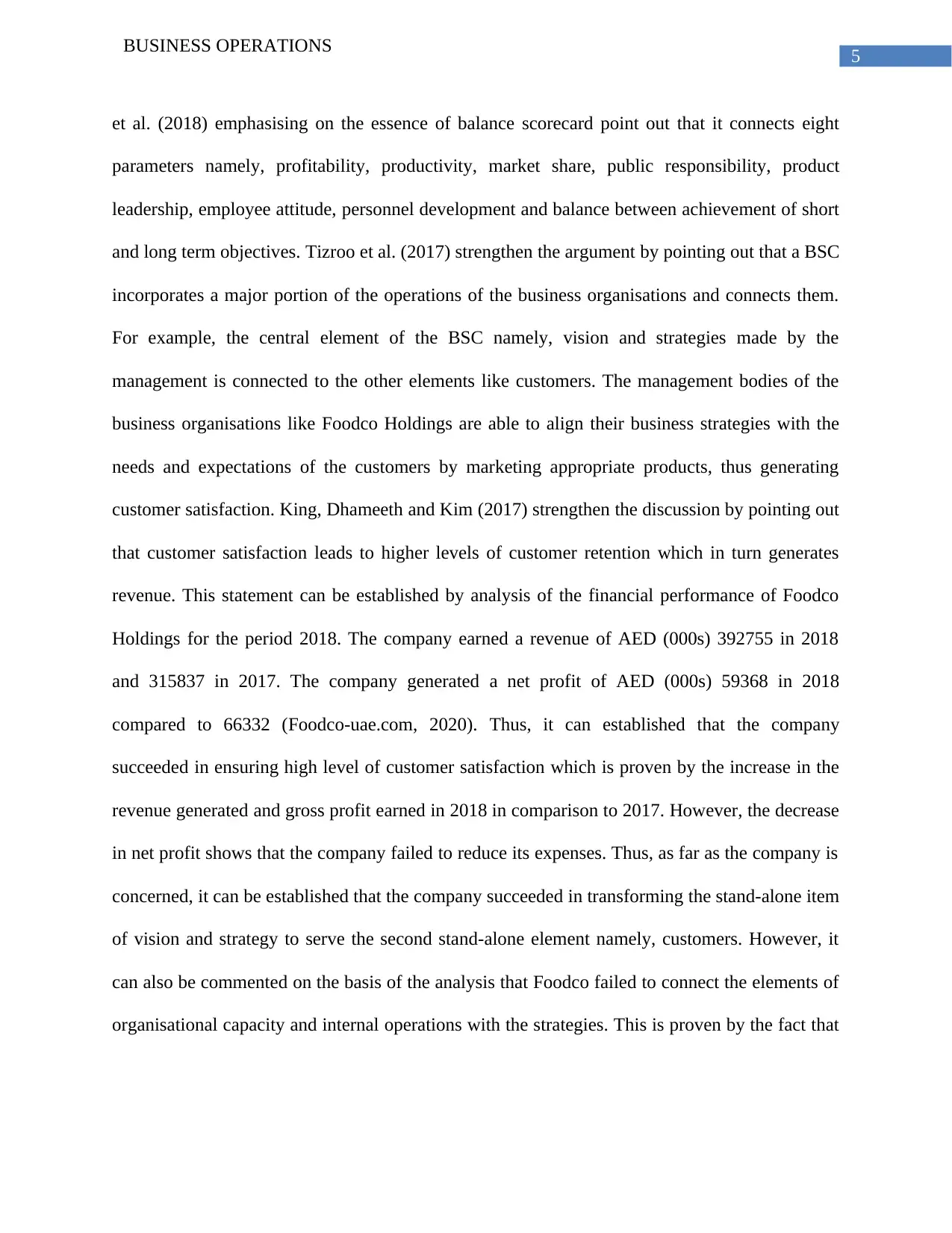
5
BUSINESS OPERATIONS
et al. (2018) emphasising on the essence of balance scorecard point out that it connects eight
parameters namely, profitability, productivity, market share, public responsibility, product
leadership, employee attitude, personnel development and balance between achievement of short
and long term objectives. Tizroo et al. (2017) strengthen the argument by pointing out that a BSC
incorporates a major portion of the operations of the business organisations and connects them.
For example, the central element of the BSC namely, vision and strategies made by the
management is connected to the other elements like customers. The management bodies of the
business organisations like Foodco Holdings are able to align their business strategies with the
needs and expectations of the customers by marketing appropriate products, thus generating
customer satisfaction. King, Dhameeth and Kim (2017) strengthen the discussion by pointing out
that customer satisfaction leads to higher levels of customer retention which in turn generates
revenue. This statement can be established by analysis of the financial performance of Foodco
Holdings for the period 2018. The company earned a revenue of AED (000s) 392755 in 2018
and 315837 in 2017. The company generated a net profit of AED (000s) 59368 in 2018
compared to 66332 (Foodco-uae.com, 2020). Thus, it can established that the company
succeeded in ensuring high level of customer satisfaction which is proven by the increase in the
revenue generated and gross profit earned in 2018 in comparison to 2017. However, the decrease
in net profit shows that the company failed to reduce its expenses. Thus, as far as the company is
concerned, it can be established that the company succeeded in transforming the stand-alone item
of vision and strategy to serve the second stand-alone element namely, customers. However, it
can also be commented on the basis of the analysis that Foodco failed to connect the elements of
organisational capacity and internal operations with the strategies. This is proven by the fact that
BUSINESS OPERATIONS
et al. (2018) emphasising on the essence of balance scorecard point out that it connects eight
parameters namely, profitability, productivity, market share, public responsibility, product
leadership, employee attitude, personnel development and balance between achievement of short
and long term objectives. Tizroo et al. (2017) strengthen the argument by pointing out that a BSC
incorporates a major portion of the operations of the business organisations and connects them.
For example, the central element of the BSC namely, vision and strategies made by the
management is connected to the other elements like customers. The management bodies of the
business organisations like Foodco Holdings are able to align their business strategies with the
needs and expectations of the customers by marketing appropriate products, thus generating
customer satisfaction. King, Dhameeth and Kim (2017) strengthen the discussion by pointing out
that customer satisfaction leads to higher levels of customer retention which in turn generates
revenue. This statement can be established by analysis of the financial performance of Foodco
Holdings for the period 2018. The company earned a revenue of AED (000s) 392755 in 2018
and 315837 in 2017. The company generated a net profit of AED (000s) 59368 in 2018
compared to 66332 (Foodco-uae.com, 2020). Thus, it can established that the company
succeeded in ensuring high level of customer satisfaction which is proven by the increase in the
revenue generated and gross profit earned in 2018 in comparison to 2017. However, the decrease
in net profit shows that the company failed to reduce its expenses. Thus, as far as the company is
concerned, it can be established that the company succeeded in transforming the stand-alone item
of vision and strategy to serve the second stand-alone element namely, customers. However, it
can also be commented on the basis of the analysis that Foodco failed to connect the elements of
organisational capacity and internal operations with the strategies. This is proven by the fact that
⊘ This is a preview!⊘
Do you want full access?
Subscribe today to unlock all pages.

Trusted by 1+ million students worldwide
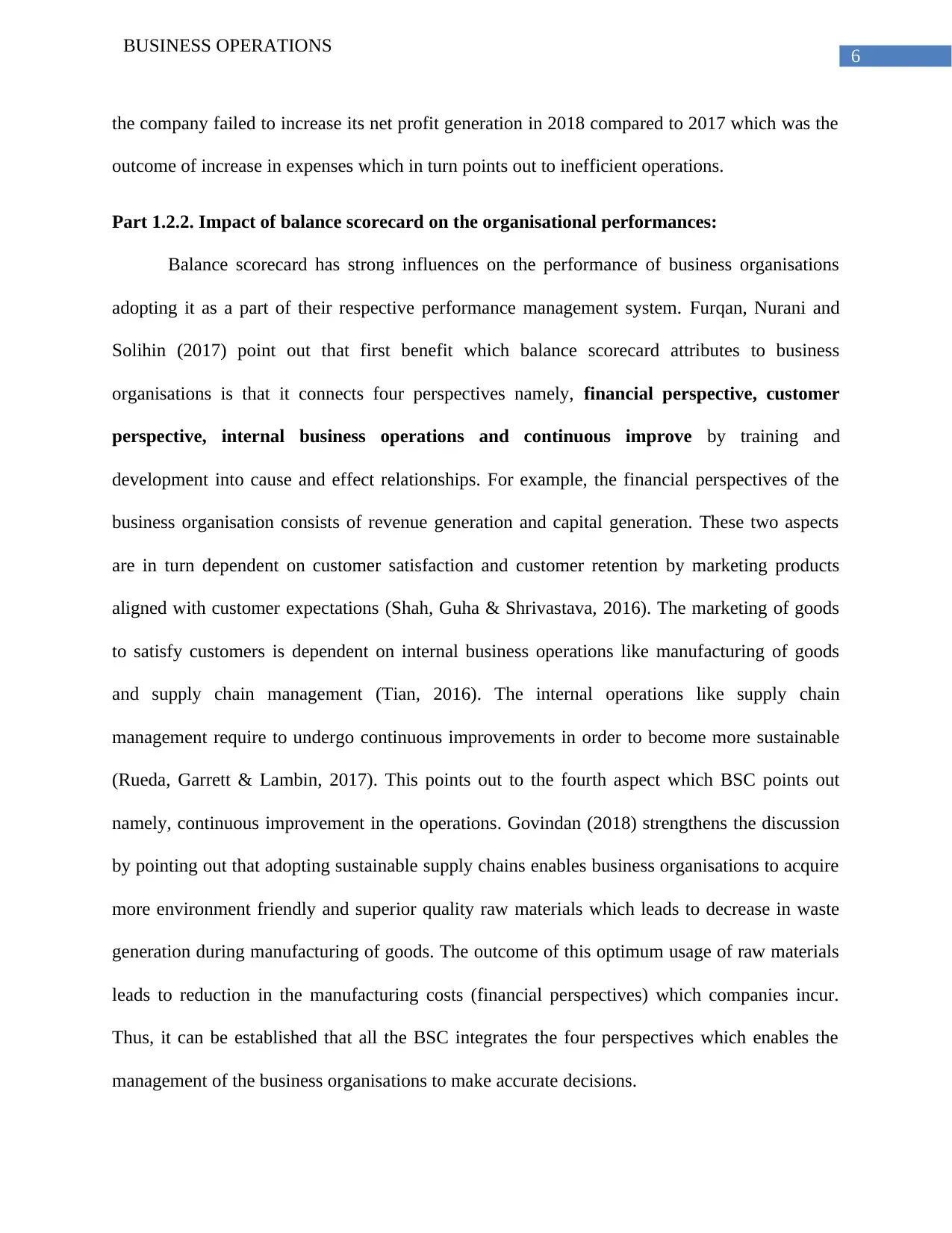
6
BUSINESS OPERATIONS
the company failed to increase its net profit generation in 2018 compared to 2017 which was the
outcome of increase in expenses which in turn points out to inefficient operations.
Part 1.2.2. Impact of balance scorecard on the organisational performances:
Balance scorecard has strong influences on the performance of business organisations
adopting it as a part of their respective performance management system. Furqan, Nurani and
Solihin (2017) point out that first benefit which balance scorecard attributes to business
organisations is that it connects four perspectives namely, financial perspective, customer
perspective, internal business operations and continuous improve by training and
development into cause and effect relationships. For example, the financial perspectives of the
business organisation consists of revenue generation and capital generation. These two aspects
are in turn dependent on customer satisfaction and customer retention by marketing products
aligned with customer expectations (Shah, Guha & Shrivastava, 2016). The marketing of goods
to satisfy customers is dependent on internal business operations like manufacturing of goods
and supply chain management (Tian, 2016). The internal operations like supply chain
management require to undergo continuous improvements in order to become more sustainable
(Rueda, Garrett & Lambin, 2017). This points out to the fourth aspect which BSC points out
namely, continuous improvement in the operations. Govindan (2018) strengthens the discussion
by pointing out that adopting sustainable supply chains enables business organisations to acquire
more environment friendly and superior quality raw materials which leads to decrease in waste
generation during manufacturing of goods. The outcome of this optimum usage of raw materials
leads to reduction in the manufacturing costs (financial perspectives) which companies incur.
Thus, it can be established that all the BSC integrates the four perspectives which enables the
management of the business organisations to make accurate decisions.
BUSINESS OPERATIONS
the company failed to increase its net profit generation in 2018 compared to 2017 which was the
outcome of increase in expenses which in turn points out to inefficient operations.
Part 1.2.2. Impact of balance scorecard on the organisational performances:
Balance scorecard has strong influences on the performance of business organisations
adopting it as a part of their respective performance management system. Furqan, Nurani and
Solihin (2017) point out that first benefit which balance scorecard attributes to business
organisations is that it connects four perspectives namely, financial perspective, customer
perspective, internal business operations and continuous improve by training and
development into cause and effect relationships. For example, the financial perspectives of the
business organisation consists of revenue generation and capital generation. These two aspects
are in turn dependent on customer satisfaction and customer retention by marketing products
aligned with customer expectations (Shah, Guha & Shrivastava, 2016). The marketing of goods
to satisfy customers is dependent on internal business operations like manufacturing of goods
and supply chain management (Tian, 2016). The internal operations like supply chain
management require to undergo continuous improvements in order to become more sustainable
(Rueda, Garrett & Lambin, 2017). This points out to the fourth aspect which BSC points out
namely, continuous improvement in the operations. Govindan (2018) strengthens the discussion
by pointing out that adopting sustainable supply chains enables business organisations to acquire
more environment friendly and superior quality raw materials which leads to decrease in waste
generation during manufacturing of goods. The outcome of this optimum usage of raw materials
leads to reduction in the manufacturing costs (financial perspectives) which companies incur.
Thus, it can be established that all the BSC integrates the four perspectives which enables the
management of the business organisations to make accurate decisions.
Paraphrase This Document
Need a fresh take? Get an instant paraphrase of this document with our AI Paraphraser
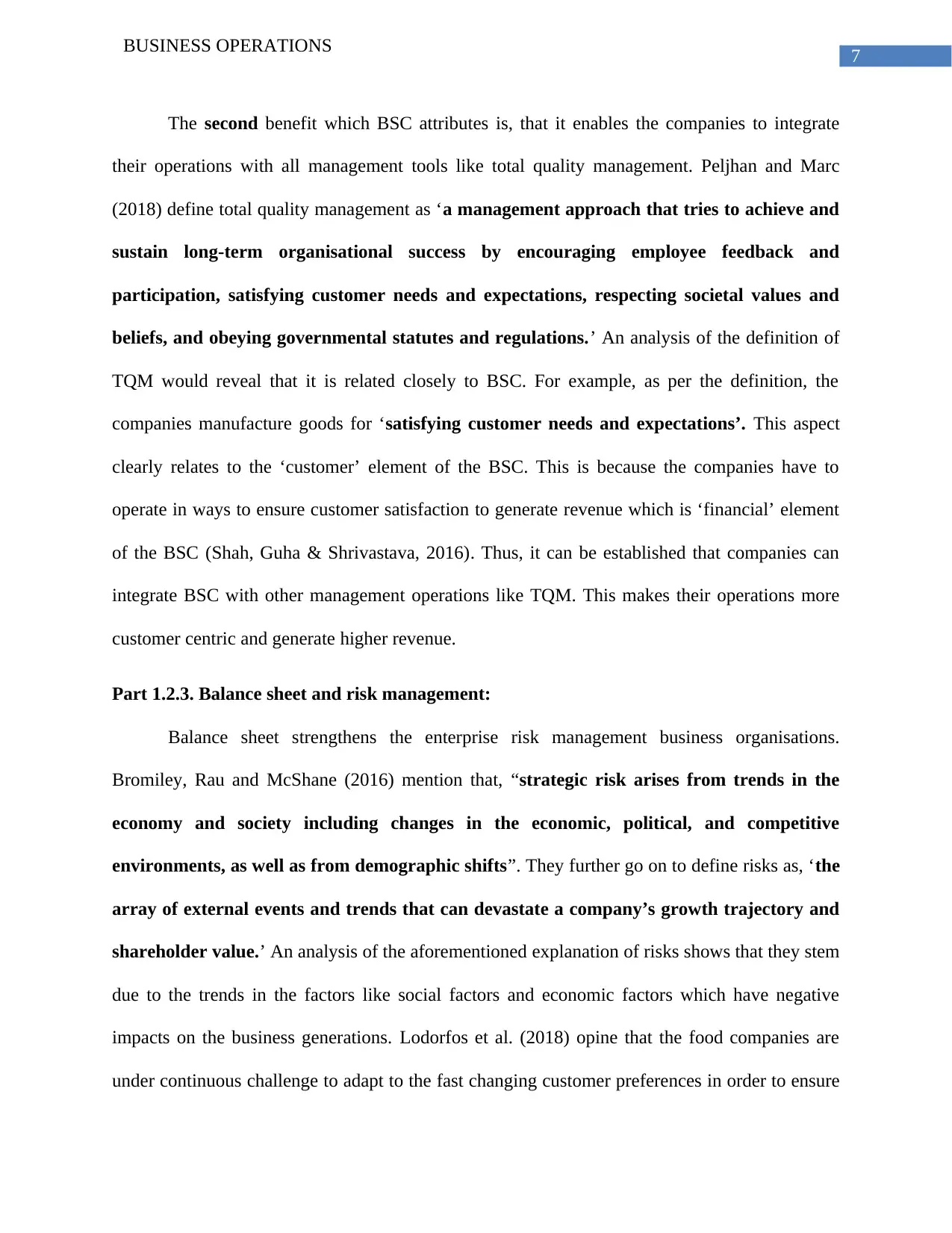
7
BUSINESS OPERATIONS
The second benefit which BSC attributes is, that it enables the companies to integrate
their operations with all management tools like total quality management. Peljhan and Marc
(2018) define total quality management as ‘a management approach that tries to achieve and
sustain long-term organisational success by encouraging employee feedback and
participation, satisfying customer needs and expectations, respecting societal values and
beliefs, and obeying governmental statutes and regulations.’ An analysis of the definition of
TQM would reveal that it is related closely to BSC. For example, as per the definition, the
companies manufacture goods for ‘satisfying customer needs and expectations’. This aspect
clearly relates to the ‘customer’ element of the BSC. This is because the companies have to
operate in ways to ensure customer satisfaction to generate revenue which is ‘financial’ element
of the BSC (Shah, Guha & Shrivastava, 2016). Thus, it can be established that companies can
integrate BSC with other management operations like TQM. This makes their operations more
customer centric and generate higher revenue.
Part 1.2.3. Balance sheet and risk management:
Balance sheet strengthens the enterprise risk management business organisations.
Bromiley, Rau and McShane (2016) mention that, “strategic risk arises from trends in the
economy and society including changes in the economic, political, and competitive
environments, as well as from demographic shifts”. They further go on to define risks as, ‘the
array of external events and trends that can devastate a company’s growth trajectory and
shareholder value.’ An analysis of the aforementioned explanation of risks shows that they stem
due to the trends in the factors like social factors and economic factors which have negative
impacts on the business generations. Lodorfos et al. (2018) opine that the food companies are
under continuous challenge to adapt to the fast changing customer preferences in order to ensure
BUSINESS OPERATIONS
The second benefit which BSC attributes is, that it enables the companies to integrate
their operations with all management tools like total quality management. Peljhan and Marc
(2018) define total quality management as ‘a management approach that tries to achieve and
sustain long-term organisational success by encouraging employee feedback and
participation, satisfying customer needs and expectations, respecting societal values and
beliefs, and obeying governmental statutes and regulations.’ An analysis of the definition of
TQM would reveal that it is related closely to BSC. For example, as per the definition, the
companies manufacture goods for ‘satisfying customer needs and expectations’. This aspect
clearly relates to the ‘customer’ element of the BSC. This is because the companies have to
operate in ways to ensure customer satisfaction to generate revenue which is ‘financial’ element
of the BSC (Shah, Guha & Shrivastava, 2016). Thus, it can be established that companies can
integrate BSC with other management operations like TQM. This makes their operations more
customer centric and generate higher revenue.
Part 1.2.3. Balance sheet and risk management:
Balance sheet strengthens the enterprise risk management business organisations.
Bromiley, Rau and McShane (2016) mention that, “strategic risk arises from trends in the
economy and society including changes in the economic, political, and competitive
environments, as well as from demographic shifts”. They further go on to define risks as, ‘the
array of external events and trends that can devastate a company’s growth trajectory and
shareholder value.’ An analysis of the aforementioned explanation of risks shows that they stem
due to the trends in the factors like social factors and economic factors which have negative
impacts on the business generations. Lodorfos et al. (2018) opine that the food companies are
under continuous challenge to adapt to the fast changing customer preferences in order to ensure
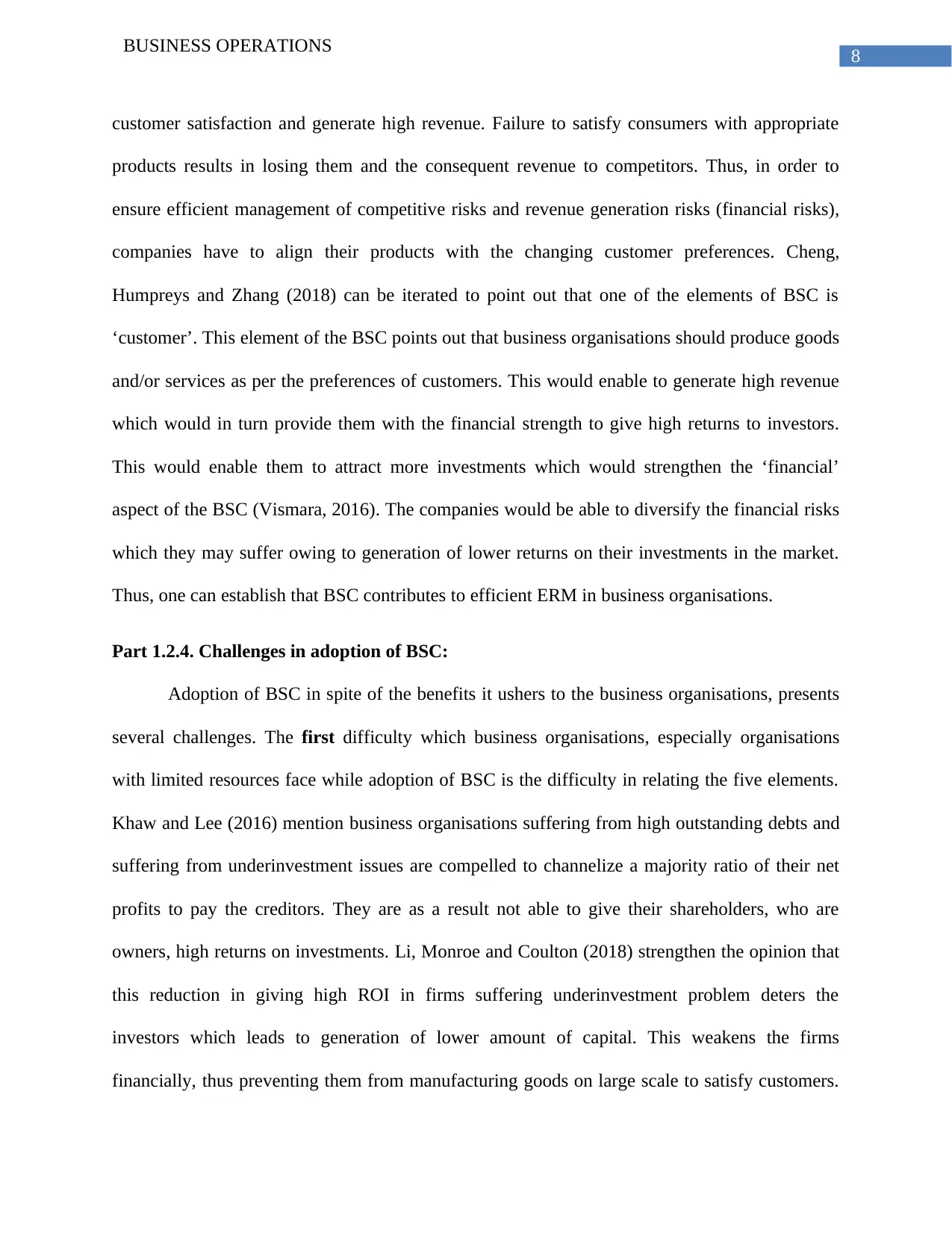
8
BUSINESS OPERATIONS
customer satisfaction and generate high revenue. Failure to satisfy consumers with appropriate
products results in losing them and the consequent revenue to competitors. Thus, in order to
ensure efficient management of competitive risks and revenue generation risks (financial risks),
companies have to align their products with the changing customer preferences. Cheng,
Humpreys and Zhang (2018) can be iterated to point out that one of the elements of BSC is
‘customer’. This element of the BSC points out that business organisations should produce goods
and/or services as per the preferences of customers. This would enable to generate high revenue
which would in turn provide them with the financial strength to give high returns to investors.
This would enable them to attract more investments which would strengthen the ‘financial’
aspect of the BSC (Vismara, 2016). The companies would be able to diversify the financial risks
which they may suffer owing to generation of lower returns on their investments in the market.
Thus, one can establish that BSC contributes to efficient ERM in business organisations.
Part 1.2.4. Challenges in adoption of BSC:
Adoption of BSC in spite of the benefits it ushers to the business organisations, presents
several challenges. The first difficulty which business organisations, especially organisations
with limited resources face while adoption of BSC is the difficulty in relating the five elements.
Khaw and Lee (2016) mention business organisations suffering from high outstanding debts and
suffering from underinvestment issues are compelled to channelize a majority ratio of their net
profits to pay the creditors. They are as a result not able to give their shareholders, who are
owners, high returns on investments. Li, Monroe and Coulton (2018) strengthen the opinion that
this reduction in giving high ROI in firms suffering underinvestment problem deters the
investors which leads to generation of lower amount of capital. This weakens the firms
financially, thus preventing them from manufacturing goods on large scale to satisfy customers.
BUSINESS OPERATIONS
customer satisfaction and generate high revenue. Failure to satisfy consumers with appropriate
products results in losing them and the consequent revenue to competitors. Thus, in order to
ensure efficient management of competitive risks and revenue generation risks (financial risks),
companies have to align their products with the changing customer preferences. Cheng,
Humpreys and Zhang (2018) can be iterated to point out that one of the elements of BSC is
‘customer’. This element of the BSC points out that business organisations should produce goods
and/or services as per the preferences of customers. This would enable to generate high revenue
which would in turn provide them with the financial strength to give high returns to investors.
This would enable them to attract more investments which would strengthen the ‘financial’
aspect of the BSC (Vismara, 2016). The companies would be able to diversify the financial risks
which they may suffer owing to generation of lower returns on their investments in the market.
Thus, one can establish that BSC contributes to efficient ERM in business organisations.
Part 1.2.4. Challenges in adoption of BSC:
Adoption of BSC in spite of the benefits it ushers to the business organisations, presents
several challenges. The first difficulty which business organisations, especially organisations
with limited resources face while adoption of BSC is the difficulty in relating the five elements.
Khaw and Lee (2016) mention business organisations suffering from high outstanding debts and
suffering from underinvestment issues are compelled to channelize a majority ratio of their net
profits to pay the creditors. They are as a result not able to give their shareholders, who are
owners, high returns on investments. Li, Monroe and Coulton (2018) strengthen the opinion that
this reduction in giving high ROI in firms suffering underinvestment problem deters the
investors which leads to generation of lower amount of capital. This weakens the firms
financially, thus preventing them from manufacturing goods on large scale to satisfy customers.
⊘ This is a preview!⊘
Do you want full access?
Subscribe today to unlock all pages.

Trusted by 1+ million students worldwide
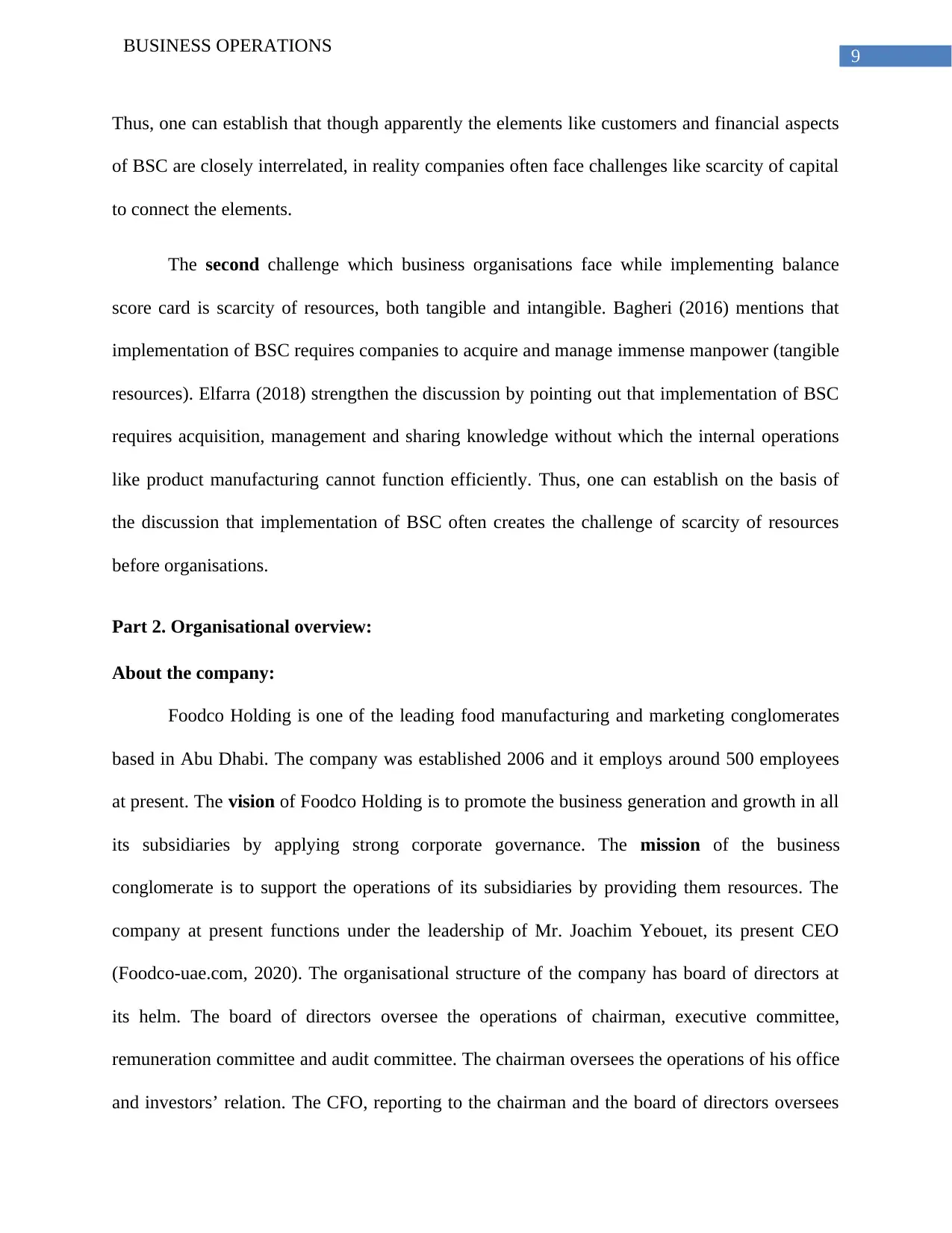
9
BUSINESS OPERATIONS
Thus, one can establish that though apparently the elements like customers and financial aspects
of BSC are closely interrelated, in reality companies often face challenges like scarcity of capital
to connect the elements.
The second challenge which business organisations face while implementing balance
score card is scarcity of resources, both tangible and intangible. Bagheri (2016) mentions that
implementation of BSC requires companies to acquire and manage immense manpower (tangible
resources). Elfarra (2018) strengthen the discussion by pointing out that implementation of BSC
requires acquisition, management and sharing knowledge without which the internal operations
like product manufacturing cannot function efficiently. Thus, one can establish on the basis of
the discussion that implementation of BSC often creates the challenge of scarcity of resources
before organisations.
Part 2. Organisational overview:
About the company:
Foodco Holding is one of the leading food manufacturing and marketing conglomerates
based in Abu Dhabi. The company was established 2006 and it employs around 500 employees
at present. The vision of Foodco Holding is to promote the business generation and growth in all
its subsidiaries by applying strong corporate governance. The mission of the business
conglomerate is to support the operations of its subsidiaries by providing them resources. The
company at present functions under the leadership of Mr. Joachim Yebouet, its present CEO
(Foodco-uae.com, 2020). The organisational structure of the company has board of directors at
its helm. The board of directors oversee the operations of chairman, executive committee,
remuneration committee and audit committee. The chairman oversees the operations of his office
and investors’ relation. The CFO, reporting to the chairman and the board of directors oversees
BUSINESS OPERATIONS
Thus, one can establish that though apparently the elements like customers and financial aspects
of BSC are closely interrelated, in reality companies often face challenges like scarcity of capital
to connect the elements.
The second challenge which business organisations face while implementing balance
score card is scarcity of resources, both tangible and intangible. Bagheri (2016) mentions that
implementation of BSC requires companies to acquire and manage immense manpower (tangible
resources). Elfarra (2018) strengthen the discussion by pointing out that implementation of BSC
requires acquisition, management and sharing knowledge without which the internal operations
like product manufacturing cannot function efficiently. Thus, one can establish on the basis of
the discussion that implementation of BSC often creates the challenge of scarcity of resources
before organisations.
Part 2. Organisational overview:
About the company:
Foodco Holding is one of the leading food manufacturing and marketing conglomerates
based in Abu Dhabi. The company was established 2006 and it employs around 500 employees
at present. The vision of Foodco Holding is to promote the business generation and growth in all
its subsidiaries by applying strong corporate governance. The mission of the business
conglomerate is to support the operations of its subsidiaries by providing them resources. The
company at present functions under the leadership of Mr. Joachim Yebouet, its present CEO
(Foodco-uae.com, 2020). The organisational structure of the company has board of directors at
its helm. The board of directors oversee the operations of chairman, executive committee,
remuneration committee and audit committee. The chairman oversees the operations of his office
and investors’ relation. The CFO, reporting to the chairman and the board of directors oversees
Paraphrase This Document
Need a fresh take? Get an instant paraphrase of this document with our AI Paraphraser
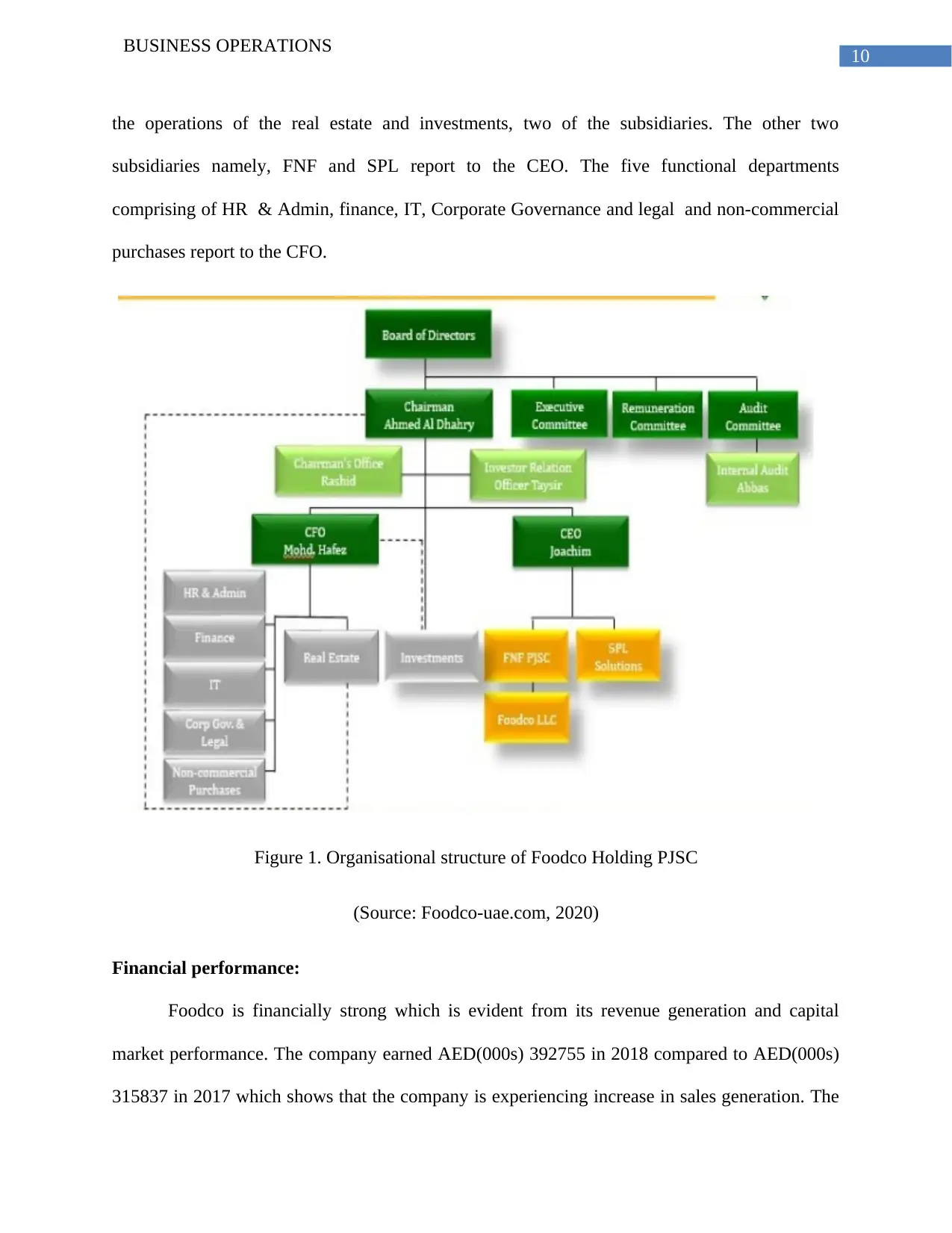
10
BUSINESS OPERATIONS
the operations of the real estate and investments, two of the subsidiaries. The other two
subsidiaries namely, FNF and SPL report to the CEO. The five functional departments
comprising of HR & Admin, finance, IT, Corporate Governance and legal and non-commercial
purchases report to the CFO.
Figure 1. Organisational structure of Foodco Holding PJSC
(Source: Foodco-uae.com, 2020)
Financial performance:
Foodco is financially strong which is evident from its revenue generation and capital
market performance. The company earned AED(000s) 392755 in 2018 compared to AED(000s)
315837 in 2017 which shows that the company is experiencing increase in sales generation. The
BUSINESS OPERATIONS
the operations of the real estate and investments, two of the subsidiaries. The other two
subsidiaries namely, FNF and SPL report to the CEO. The five functional departments
comprising of HR & Admin, finance, IT, Corporate Governance and legal and non-commercial
purchases report to the CFO.
Figure 1. Organisational structure of Foodco Holding PJSC
(Source: Foodco-uae.com, 2020)
Financial performance:
Foodco is financially strong which is evident from its revenue generation and capital
market performance. The company earned AED(000s) 392755 in 2018 compared to AED(000s)
315837 in 2017 which shows that the company is experiencing increase in sales generation. The
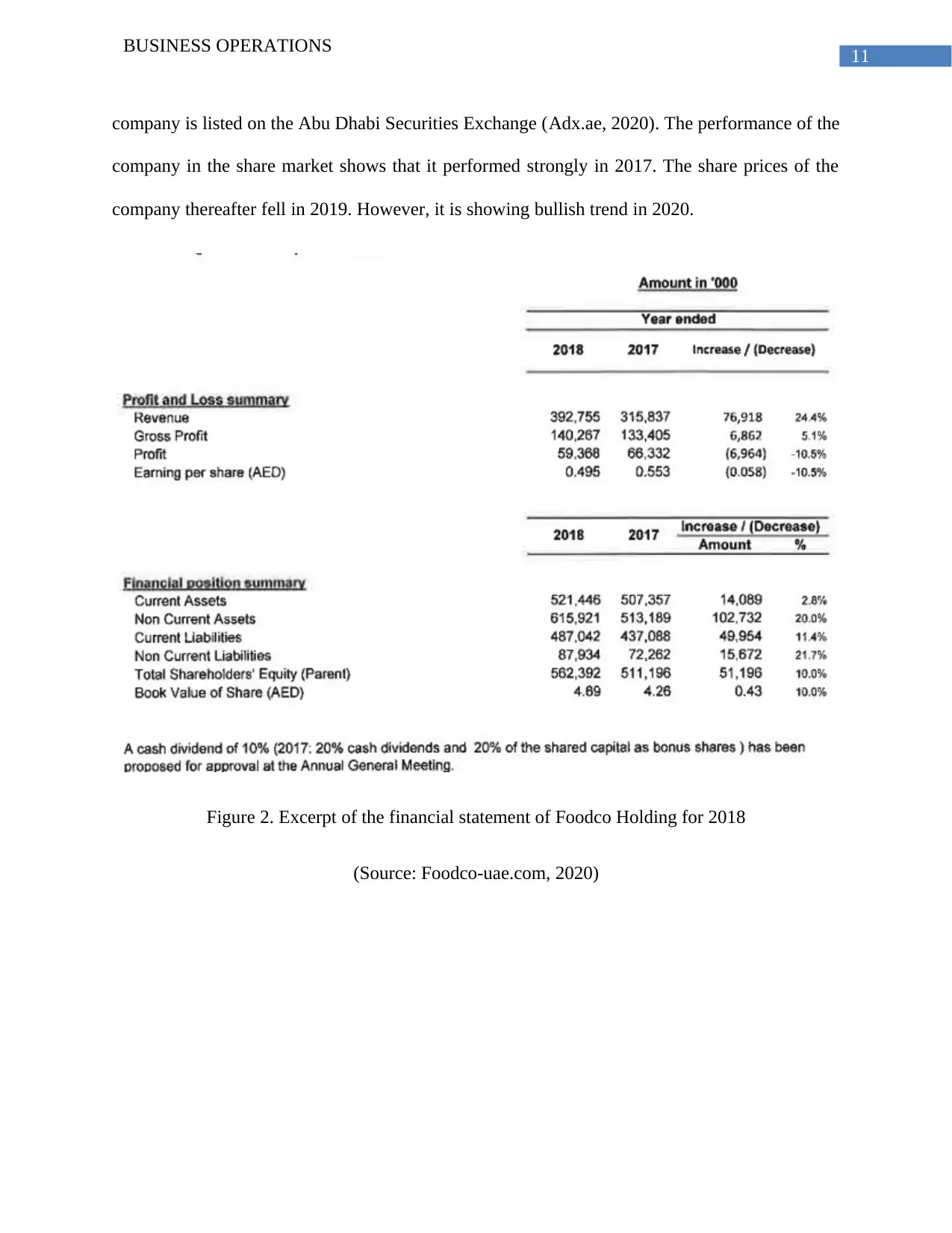
11
BUSINESS OPERATIONS
company is listed on the Abu Dhabi Securities Exchange (Adx.ae, 2020). The performance of the
company in the share market shows that it performed strongly in 2017. The share prices of the
company thereafter fell in 2019. However, it is showing bullish trend in 2020.
Figure 2. Excerpt of the financial statement of Foodco Holding for 2018
(Source: Foodco-uae.com, 2020)
BUSINESS OPERATIONS
company is listed on the Abu Dhabi Securities Exchange (Adx.ae, 2020). The performance of the
company in the share market shows that it performed strongly in 2017. The share prices of the
company thereafter fell in 2019. However, it is showing bullish trend in 2020.
Figure 2. Excerpt of the financial statement of Foodco Holding for 2018
(Source: Foodco-uae.com, 2020)
⊘ This is a preview!⊘
Do you want full access?
Subscribe today to unlock all pages.

Trusted by 1+ million students worldwide
1 out of 18
Related Documents
Your All-in-One AI-Powered Toolkit for Academic Success.
+13062052269
info@desklib.com
Available 24*7 on WhatsApp / Email
![[object Object]](/_next/static/media/star-bottom.7253800d.svg)
Unlock your academic potential
Copyright © 2020–2025 A2Z Services. All Rights Reserved. Developed and managed by ZUCOL.





